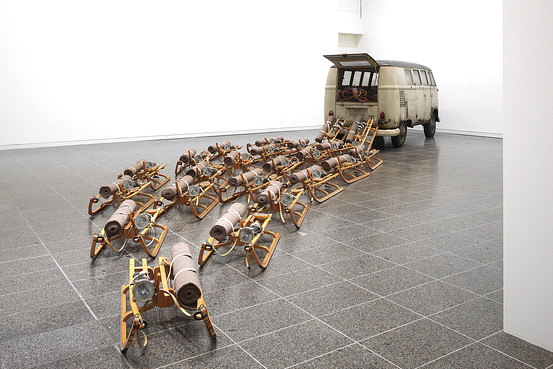
Joseph Beuys, The Pack. Installation View, 1969.
In Matt Ratto’s Critical Making: Conceptual and Material Studies in Technology and Social Life, he suggests that artists, makers and designers have an opportunity to utilize or rather to create works using digital hardware and software programs; to engage in both material and conceptual critiques of technologies and information systems (Ratto, 2011, pg. 252-253). Ratto’s article depicts the transformative possibilities of creative decision making; the potential “to use material forms of engagement with technologies to supplement and extend critical reflection…to reconnect our lived experiences with technologies to social and conceptual critique” (Ratto, 2011, pg. 253).
German Fluxus artist Joseph Beuys’ piece The Pack, exemplifies Ratto’s term critical making, whereby the artists engagement with materials bridges the gap between creative physical and conceptual explorations. In The Pack, twenty-four sledges (carrying survival kits and felts) fall from the back of a Voltswagen Van. Beuys’ piece conceptually reflects on societies disconnect with technology and material experience, offering audiences insight into a turning point in Beuys critical making career, whereby he creates a conceptual work of art that poignantly depicts a lived experience, which by design then becomes a matter of concern (Ratto, 2011, pg. 259) for the masses.
Works Cited
Ratto, Matt. “Critical making: Conceptual and material studies in technology and social life.” The Information Society 27.4 (2011): 252-260.
Beuys, Joseph. The Pack, 1969. Installation.
Works Consulted
Mitchell, WJ Thomas, and Mark BN Hansen, eds. Critical terms for media studies. University of Chicago Press, 2010.
Scribner, Charity. “Object, relic, fetish, thing: Joseph Beuys and the museum.” Critical Inquiry 29.4 (2003): 634-649.
Shanken, Edward A. “Art and electronic media.” (2009).
Add yours Comments – 1
Thanks for this post. I love to see these connections being made. I also find it an interesting exercise to connect newer theoretical frameworks–i.e. critical making– to earlier movements, practices, and writing that function as precedents. Artists have long used material forms and engagements with technologies to speak to broader social and political themes–so how is critical making different? To which artistic and technical legacies is the critical making movement indebted, if any? Looking at this Beuys piece is helpful in thinking through different intentions, agendas, and historical moments in which these artistic and critical making experiments are taking place. Any other thoughts?